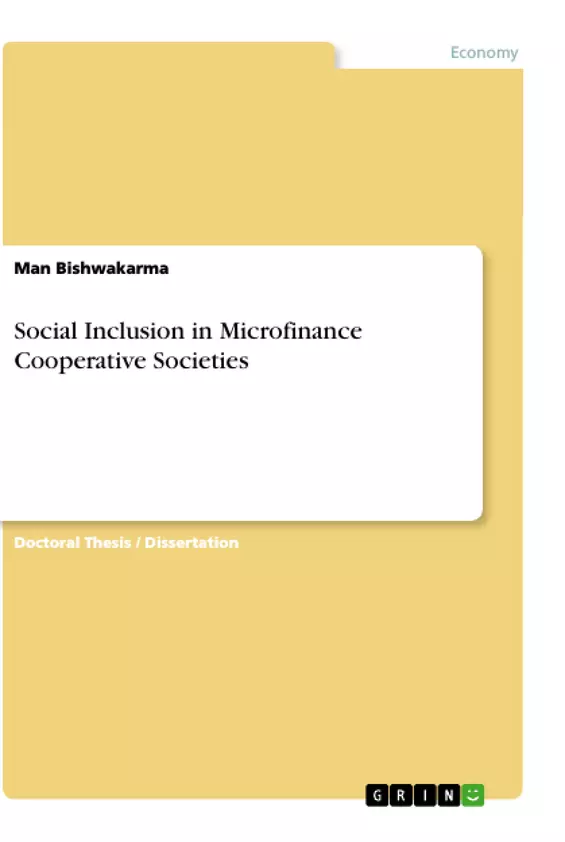Microfinance, in these days, has become a global concern. Generally, microfinance means the financial services to the poor. Most of the micro-finance initiatives have economic goals of reducing poverty and tackling the marginalization of the poor particularly the deprived section of the society. Microfinance is a mix of financial and social intermediation. It was commenced through cooperative from the mid-19th century with initiating the saving of 28 pounds from a group of factory workers of ‘Rochdale society of equitable pioneers’ in the United Kingdom. In Germany, Freidrich Raiffeisen introduced the community based credit cooperative society in 1864. It was the first Credit Organization in the world. In Asia, the concept of cooperative introduced officially in 1904 from India and further extended to other countries. Similarly, the popular model of microfinance developed in latter century is Grameen Bank model pronounced by Muhammad Yunus in 1976.
Social exclusion discourses developed in response to criticisms of the term poverty and describe the process that leads to individuals or groups being wholly or partly excluded from full participation in society. Nepal remained as Hindu kingdom for a long time; most social and cultural value has been dominated by the caste hierarchical system. Age long caste-based practices made “Dalits” most deprived in the society. Building inclusive financial system has been the global agenda since the start of twenty first century. Likewise, social inclusion has been the top political agenda around the globe.
Social Inclusion Factor established in this research is a noble tool to measure the magnitude of inclusiveness. One of the major findings is that inclusiveness promotes sustainability. Likewise, small income changes for the very poor have proportionately much greater impacts on livelihood, than those for the better off.
The research has come out with some recommendations with some new approaches in microfinance to make it more inclusive. Credit-first approach to the most deprived groups based on analyzing poverty status of the clients is one. Likewise, providing credit plus intermediation on the basis of individual capacity deprivation is other recommendation which emphasizes on individual intervention to the most deprived clients/members. Considering the complexities of MFC it has structured an approach called “community owned microfinancing” to reach down to the poorest of the poor .
Inhaltsverzeichnis (Table of Contents)
- Introduction
- Literature Review
- The Concept of Social Inclusion
- Microfinance: A Conceptual Overview
- Social Exclusion and Microfinance
- Social Inclusion and Microfinance
- Methodology
- Research Design
- Data Collection
- Data Analysis
- Findings and Analysis
- Social Inclusion and Microfinance: An Empirical Analysis
- Challenges of Social Inclusion in Microfinance
- Community-Owned Micro-Banking: A Proposed Model
- Conclusion
Zielsetzung und Themenschwerpunkte (Objectives and Key Themes)
This dissertation investigates the dynamics of social inclusion and exclusion within the context of microfinance, focusing on cooperative societies in Nepal. The research aims to understand how microfinance practices can contribute to social inclusion while also identifying challenges that hinder equal access to financial services.
- Social Inclusion in Microfinance
- The Role of Cooperative Societies in Promoting Social Inclusion
- Challenges to Social Inclusion in Microfinance
- The Impact of Microfinance on Poverty Reduction and Economic Empowerment
- The Development of a Community-Owned Micro-Banking Model for Enhanced Social Inclusion
Zusammenfassung der Kapitel (Chapter Summaries)
The dissertation begins with an introduction to the topic of social inclusion in microfinance, outlining the research objectives and providing a contextual overview of the microfinance landscape in Nepal. The literature review examines the theoretical underpinnings of social inclusion and exclusion, exploring the relationship between microfinance and social inclusion. The methodology chapter describes the research design, data collection methods, and data analysis techniques employed in the study.
The findings and analysis chapter presents empirical evidence on the relationship between social inclusion and microfinance in Nepal. This section explores the challenges that hinder social inclusion in microfinance, including issues of gender, caste, and ethnicity. Finally, the dissertation proposes a community-owned micro-banking model that aims to address these challenges and enhance access to financial services for marginalized groups.
Schlüsselwörter (Keywords)
The main focus of this dissertation lies on the relationship between microfinance and social inclusion, particularly within the context of cooperative societies in Nepal. Key terms and concepts include social inclusion, social exclusion, microfinance, cooperative societies, community-owned micro-banking, access to finance, poverty reduction, economic empowerment, and marginalized groups.
- Citar trabajo
- Dr. Man Bishwakarma (Autor), 2010, Social Inclusion in Microfinance Cooperative Societies, Múnich, GRIN Verlag, https://www.grin.com/document/1132021



